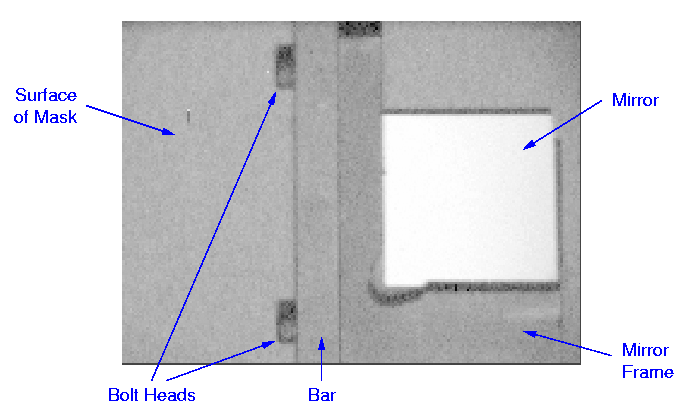LRIS Pickoff Mirror
The pickoff mirror is a small (1-in. sq.) piece of aluminized glass attached
to the bar near the center of the slitmask, within the field of the
slit-viewing camera.
The pickoff mirror was proposed by Sandy Faber as a means to
avoid any flexure or rotator errors that could produce slitmask
misalignment when guiding with the offset guider.
The principle is that the mirror is
rigidly ``tied'' to the slits in the slitmask, and
so holding a star in position with respect to the
edge of the mirror (that is, tying the mirror to the sky)
would guarantee that [translational] alignment is
maintained with the slitlets. This is, in effect, guiding directly off
the slitmask. Note that rotator errors could still be present, but
their effects will be more than halved since the pivot point
is near the center of the mask, rather than off one end.
Here's the pick-off mirror as seen by the LRIS slit-viewing camera:

In this picture, you see the bar (just left of center) running vertically. The
pickoff mirror is the bright square and the frame that holds it is
L-shaped. The frame is attached to the bar by two small bolts, whose
heads protrude to the left of the bar. The upper right, extreme right edge,
and left are the slitmask surface itself.
Specs
There are seven pickoff mirrors in existence at this time, all
fitting the same side of the bar (mirrors on the other side are
not completely imaged by the slit-viewing camera). The mirrors
are made from aluminized microscope slide glass, and are
not all uniform in size. The approximate
dimensions are 22mm -- about 30 arcsec -- on a side.
The frame holds the mirror at a slight angle to reflect the beam of
light into the slit-viewing camera.
Since the images are in focus at the surface of the slitmask (and hence the
mirror), changes in the tilt of the mirror will not cause the image
to shift in the slit-viewing camera to first order.
(In actual fact, the surface of the mirror
is slightly above the slitmask surface, in order to bring a star into
focus at the same height as the polished longslit jaws -- i.e., where the
slit-viewing camera is focused.)
Use
During slitmask design, you want to make sure a guide star of
appropriate magnitude falls well within the edges of the mirror.
The location of the mirror is shown in the ``simulator'' display.
After centering on your field (direct image),
insert the slit mask and
change over to the slit-viewing camera. Your guide star should
appear in the small image of the pickoff mirror. After final alignment
of the mask,
grab an image from the slit-viewing camera and measure the location
of the star and edges. You may want to check periodically that
there is no drift in the stellar position with respect to the mirror
edges (we've only seen very rare instances where drifts have occured).
Non-Standard Disclaimer
This description of the pickoff mirrors is accurate to the best
of my knowledge, but it hasn't been independently checked for
accuracy, and sometimes things change without my knowledge.
Use of the mirrors is entirely at the risk of the user (but we've
been very successful with them).
Send comments to
phillips@ucolick.org.
Andrew C. Phillips / Lick Observatory
Last modified: 30 jul 96
phillips@ucolick.org

